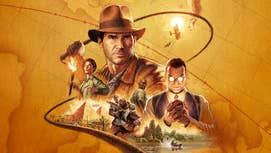Indiana Jones and the Great Circle's central concept based on real-world theory involving ancient sites
Sounds right in Indy's wheelhouse.
MachineGames has revealed the storyline of Indiana Jones and the Great Circle centers around a real-world hypothesis that claims ancient sites around the world were intentionally built in alignment, forming what's called a Great Circle.
Speaking in an interview with Lucasfilm, game director Jerk Gustafsson shared how the unorthodox theory of a Great Circle connecting ancient sites inspired the title’s plot.
“A great circle is any circle that divides a sphere in half,” said Gustafsson. “On Earth, the most well-known one is, obviously, the equator. But they can exist from any point really, and are used heavily in aviation when plotting your course.
“It turns out there is a very real and mysterious great circle that is not the equator, but one that connects many of history’s greatest historical sites such as Giza, Easter Island, Sukhothai, Nazca, and many more. Their connection has remained a mystery, and this provides the perfect adventure for our game.”
MachineGames worked on the synopsis with Bethesda’s Todd Howard, who for years entertained the idea of developing a story-based game inspired by the unconventional hypothesis.
While such a topic befits the Indiana Jones universe, to ensure the storyline correlated with the larger narrative of the films, MachineGames enlisted the help of Lucasfilm.
“When we come into the story, it’s almost a year after Raiders, and we wanted to explore where Indy would be at this time, having just separated from Marion, being sort of lost again, adrift in his obsessions with his work,” said Gustafsson.
“For that, we had enormous help from the team at Lucasfilm Games, in addition to vetting the story with them for creative feedback making sure that we stayed true to the franchise.”
To explain the Great Circle
The Great Circle theory, posited by Jim Alison and published online in 1995, suggests many of the world's ancient structures connect via a large, unbroken circle. Some ancient sites don't perfectly align with the proposed line, but their inclusion is justified because they're only off by one degree or less.
Ancient sites said to align within a great circle include Easter Island, Nazca, Ollantaytambo, and Giza. Sites sitting slightly off the line include Petra, Perseopolis, Ollantaytambo, Machupicchu, the Oracle of Amun (Ammon) at Siwa Oasis, Mohenjo Daro, Ur, and Angkor Wat, among others. This circle encompasses not only explored landmasses, but uncharted territories and submerged depths where ancient sites potentially rest.
Other great circles include the equator and meridians of longitude crossing over the north and south poles.
The idea of ancient societies deliberately constructing sacred sites in alignment was first theorized in 1846, and the notion struck a chord with many in the early 20th century. The theory led to some supporters discerning lines connecting England's enigmatic monuments, megaliths, and medieval churches. These alignments became known as ley lines.
Currently, the controversial theories of ley lines and the Great Circle are not factually supported, leading both to be categorized as pseudoarchaeology or pseudoscience by many historians, archeologists, and anthropologists. While there are outliers in these disciplines, those who research or posit the validity of ancient alignments often encounter derision and the very real threat of professional ostracization.
All said, drawing lines on a map or circles around the globe may temptingly connect far-flung historical sites, such patterns only fuel speculation, and will remain mere coincidences until rigorous evidence supports it.
However, the idea of our ancestors harmonizing monuments across continents as a unified vision is a rather interesting premise for a video game.
Indiana Jones and the Great Circle was finally revealed earlier this week during Xbox Developer Direct and is slated for release later this year on Game Pass, PC, and Xbox Series X/S.
.jpg?width=690&quality=80&format=jpg&auto=webp)




.png?width=291&height=164&fit=crop&quality=80&format=jpg&auto=webp)






